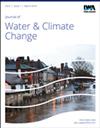水资源管理系统的二类模糊机会约束线性分式规划模型——以太原市为例
IF 3.1
4区 环境科学与生态学
Q2 WATER RESOURCES
引用次数: 0
摘要
极端气候事件和人类活动带来的不确定性对水资源的有效配置提出了挑战。本文将2型模糊集、机会约束规划和分数规划结合到一个综合的多目标优化框架中,提出了支持不确定条件下水资源管理系统的2型模糊机会约束线性分式规划(tf2 - cclfp)。该模型实现了经济、社会和环境可持续性之间的权衡,并提供了与不同程度的模糊不确定性和违反约束风险相关的供水解决方案。以山西省太原市为例,应用T2F-CCLFP模型支持太原市水资源管理。结果表明:(1)产业结构正从以能源、重工业为主向多元化转型;(ii)外调水将是未来城市的主要供水来源,2025年和2030年分别占城市总供水量的55%和50%;(三)促进中水利用,提高了城市供水安全(年增长率为13.9%)。研究结果有助于管理者调整当前产业结构,增强供水安全,促进社会经济和水系统的可持续发展。本文章由计算机程序翻译,如有差异,请以英文原文为准。
Type-2 fuzzy chance-constrained linear fractional programming model for a water resource management system: a case study of Taiyuan city, China
Abstract Uncertainties arising from extreme climate events and human activities pose a challenge to the efficient allocation of water resources. In this study, a type-2 fuzzy chance-constrained linear fractional programming (T2F-CCLFP) is developed to support the water resource management system under uncertainty by incorporating type-2 fuzzy sets, chance-constrained programming, and fractional programming into a comprehensive multi-objective optimization framework. The model enables the trade-off between economic, social, and environmental sustainability and provides water supply solutions associated with different levels of fuzzy uncertainty and risk of violating constraints. The T2F-CCLFP model is applied to Taiyuan, Shanxi Province, China, to support its water resource management. Results reveal that (i) the industrial structure is transitioning toward diverse industries from energy and heavy industry dominance; (ii) external water transfer will be the major water-supply sources for the city in the future, accounting for 55 and 50% of the total water supply in 2025 and 2030, respectively; (iii) the water-supply security of the city is enhanced by provoking the utilization of reclaimed water (the annual growth rate is 13.9%). The results are helpful for managers in adjusting the current industry structure, enhancing water supply security, and contributing to the sustainable development of socio-economic and water systems.
求助全文
通过发布文献求助,成功后即可免费获取论文全文。
去求助
来源期刊

Journal of Water and Climate Change
WATER RESOURCES-
CiteScore
4.80
自引率
10.70%
发文量
168
审稿时长
>12 weeks
期刊介绍:
Journal of Water and Climate Change publishes refereed research and practitioner papers on all aspects of water science, technology, management and innovation in response to climate change, with emphasis on reduction of energy usage.
 求助内容:
求助内容: 应助结果提醒方式:
应助结果提醒方式:


